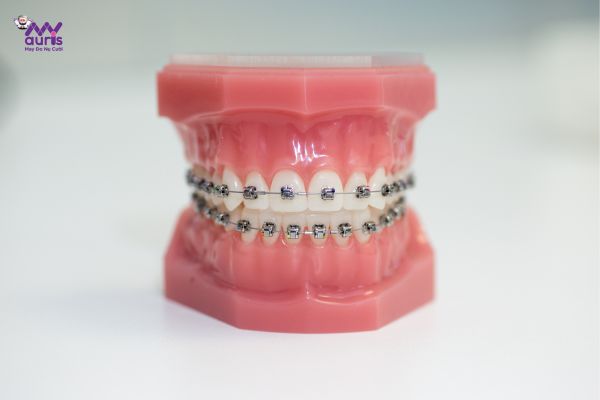Braces is an orthodontic method that uses force tools to pull and correct misaligned teeth to the correct position on the jaw. From there, it helps the face to be balanced and become more harmonious. Therefore, many people wonder whether braces can correct the jaw. To answer in detail the issue of dental braces, let’s find out with My Auris through the following article.
Understand more about jaw misalignment
Jaw misalignment is a condition in which the two jaws are misaligned and disproportionate. When observing the face, it can be seen that the face is deviated to the left or right or is overdeveloped forward or backward. This not only makes the face unbalanced, seriously affecting aesthetics, but also affects chewing, pronunciation, temporomandibular joint pain as well as many other dental problems.
There are many causes of jaw misalignment. Learning and understanding the causes will help people find the most appropriate and effective way to fix them.
- Congenital: there are many cases where children are born with a misaligned jaw, so their faces are unbalanced and disharmonious.
- Due to bad habits in daily life: during the period of jaw bone development, if children often hold their chin, lie on one side, push their tongue, suck on a pacifier, chew on one side,… it will cause the jaw structure to have problems such as malocclusion and jaw misalignment.
- Jaw dislocation due to injury or accident: there are many accidents that happen in life, sometimes these accidents cause impact and misalignment of the jaw and the face is no longer balanced.
- Due to uneven development of the jaw bone leading to imbalance: there are 3 cases occurring such as: 1 side develops normally – 1 side is overdeveloped, 1 side develops normally – 1 side is underdeveloped and 1 side develops excessively – 1 side is underdeveloped.
- Misaligned jaw due to teeth: misaligned, misaligned and misaligned teeth also create deviations in the jaw.

Jaw misalignment causes many effects on oral health and facial aesthetics. Finding out the exact cause will help people have effective treatment and recovery plans.
Classification of cases of jaw misalignment
To determine which treatment and correction method is appropriate, doctors will have to check and diagnose the type of jaw misalignment. There are 3 types of jaw misalignment, specifically:
Tooth misalignment
This is a case where the jaw bone has normal development, but when the teeth are misaligned, it leads to a misaligned bite, leading to a misaligned face. In this case, doctors will have dental interventions to fix it. After adjusting the teeth, the face will also become balanced and harmonious.
Jaw misalignment due to the jaw bone
In contrast to jaw misalignment due to teeth, jaw misalignment is caused by abnormal bone structure development, while the teeth grow in the correct position. At this time, the jaw can be deviated to the left, right, pushed forward or backward. In these cases, jaw surgery will be more effective than tooth intervention. After adjusting the jaw bone, the bone structure will be balanced. the face becomes harmonious.
Major misalignment caused by both teeth and bones
This is a more complicated condition because jaw misalignment is caused by both bones and teeth result.

Can orthodontic braces fix it?
As mentioned, depending on the type of misalignment, there is a suitable treatment method. Braces are an orthodontic solution that helps the teeth to be straightened and aligned on the jaw thanks to the impact of the appliance. Therefore, this method only interferes with the teeth and does not interfere with the jaw bone Only effective when misalignment is caused by teeth.
For jaw misalignment caused by jaw bone, surgical intervention is required to adjust the jaw bone in balance and harmony. With jaw misalignment caused by both teeth and bone, the treatment regimen will have to combine orthodontic braces and jaw surgery to bring about optimal results.
So whether orthodontic braces can correct or not depends on each person’s misalignment. To determine which treatment method is appropriate, people should see a dentist for examination and diagnosis.

Current orthodontic braces methods
Currently, there are two main methods of braces: fixed braces and removable braces. Depending on the condition, degree of misalignment, economic conditions and needs of each person, the doctor will advise customers on choosing the appropriate orthodontic method.
Metal braces
Metal braces are divided into 2 types: regular braces and self-locking braces. For the traditional method, using brackets is usually installed on the surface of the tooth, wire is inserted into the bracket and fixed with an elastic band. Meanwhile, self-locking braces are designed to improve on traditional braces, so there are additional automatic opening and closing locks that help the wire slide freely without using the wire. Elastic braces.
In general, metal braces are highly effective, suitable for mild to complex cases of misalignment, and the orthodontic time is quick. However, braces are often more likely to slip off, easily breaking the elastic, affecting the speed of orthodontics. Metal braces are easily exposed on the tooth surface, so they are not suitable Appreciated.

Ceramic braces
Similar to metal braces, There are also two types of ceramic braces: regular ceramic braces and self-locking braces. The operating principle is the same as metal braces, the difference is in the material that makes the braces, not metal. Therefore, the color of the braces matches the color of the teeth and provides better aesthetics when braced.
Therefore, the orthodontic time may be longer and during the orthodontic process you need to be careful to avoid broken/cracked brackets. src=”https://myauris.vn/wp-content/uploads/2023/12/nieng-rang-chinh-ham-co-khac-phuc-duoc-khong-5.jpg” decoding=”async” class=”size-full wp-image-39143″ alt=”jaw orthodontic braces” width=”600″ height=”400″>
Transparent braces
Transparent braces are also known as removable braces or invisible braces. This method uses flexible, removable devices such as brackets and wires. Therefore, the orthodontic process brings more benefits and convenience.
Transparent braces are designed from transparent plastic, with personalized parameters, hugging the tooth arches to exert force. The biggest advantage of this method that many people love is its high aesthetics.

Thus, each orthodontic appliance, including brackets, wires or transparent braces, has its own advantages and disadvantages. Depending on the needs, each customer has the appropriate choice to correct deviations, bringing aesthetics and better chewing.
Hopefully the information in the article about dental orthodontics helps people better understand the condition and methods to fix it. If you still have concerns, please contact My Auris Dental immediately for advice, answers or to schedule an examination as soon as possible.





